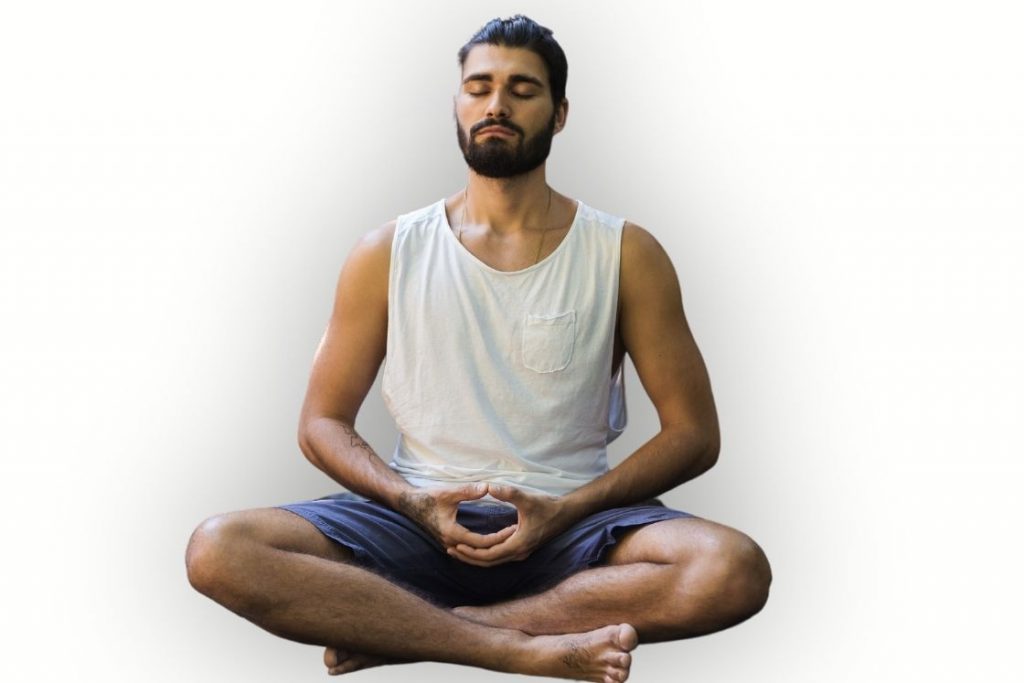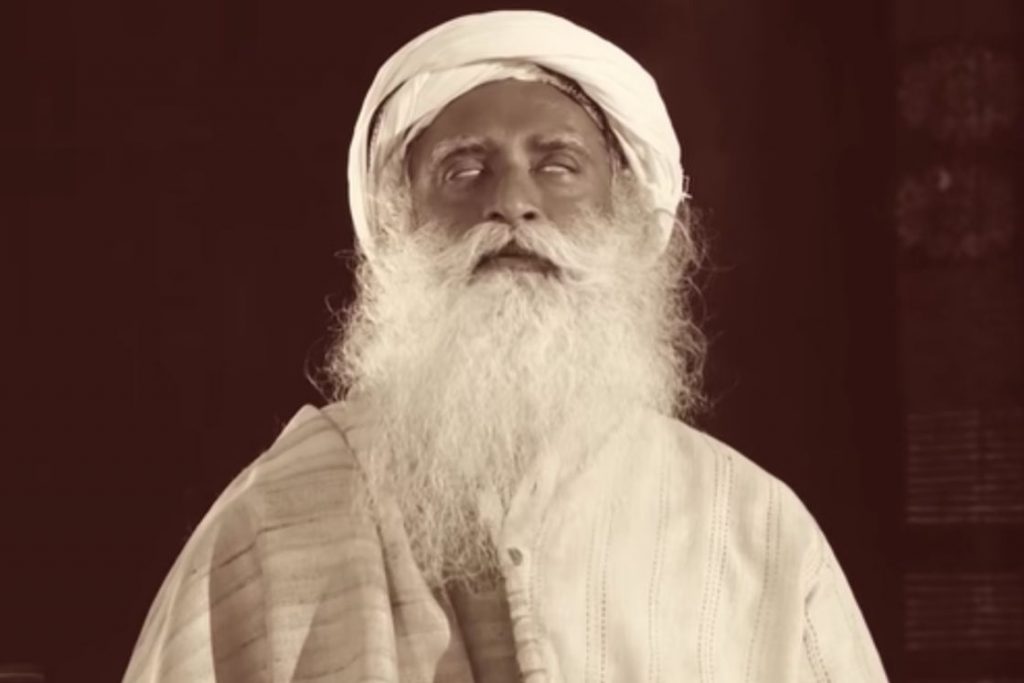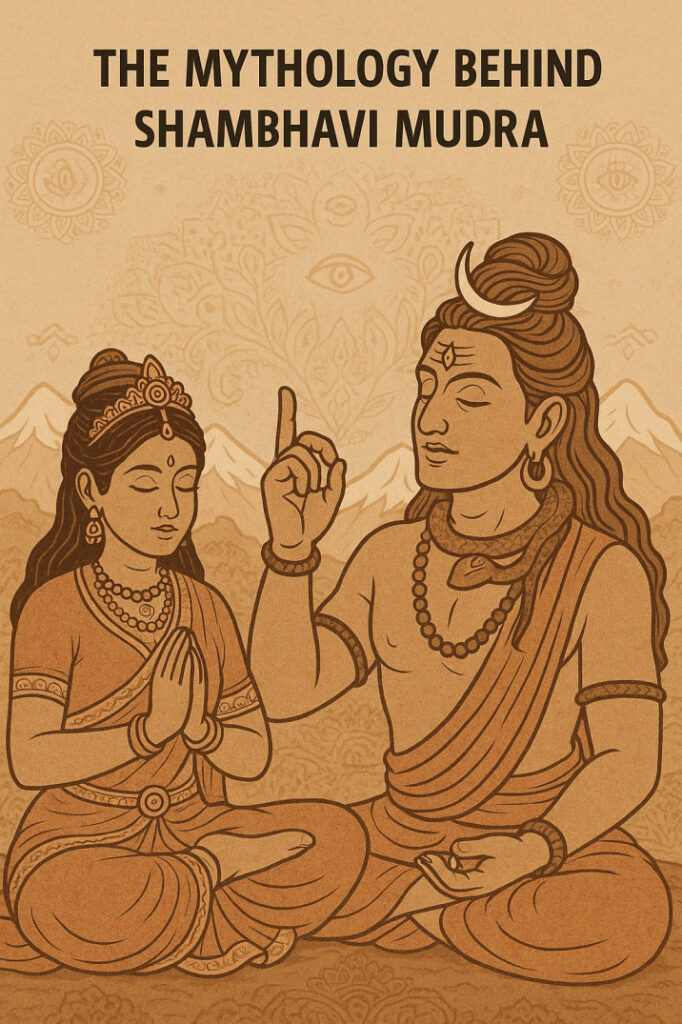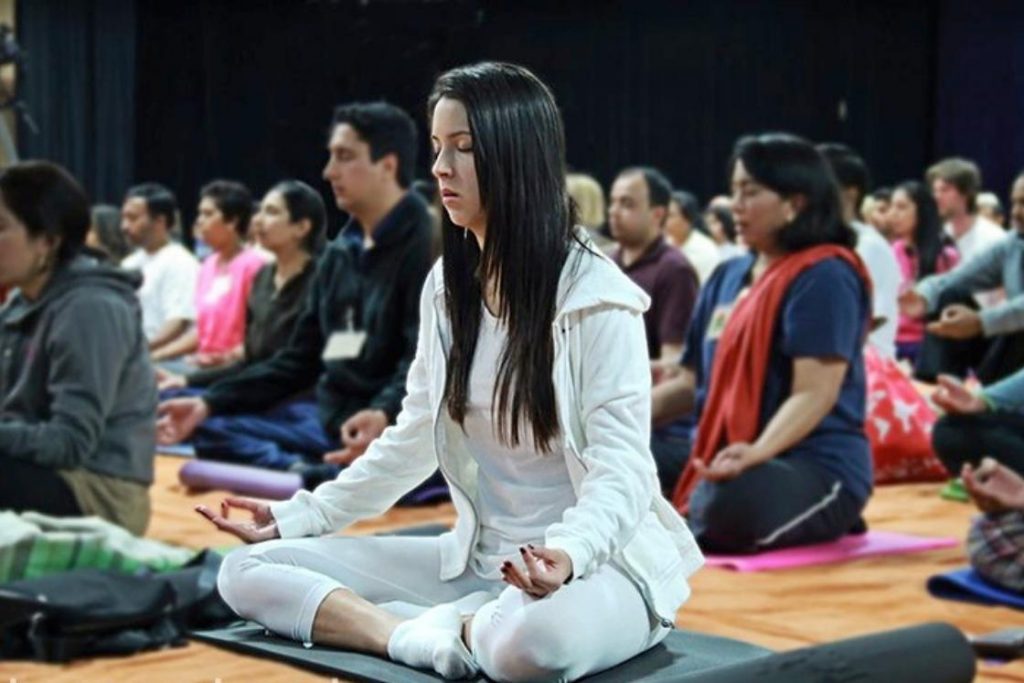- About Shambhavi Mudra
- How to prepare for it
- How to do it
- Shambhavi Mudra Benefits
- Precautions
- About Shambhavi Mahamudra
- Steps to perform it
- Shambhavi Mahamudra Benefits
- Differences

Most mudras for meditation that we do today are either closed eyes or open eyes meditation techniques. A very few mudras are performed with half-open eyes; Shambhavi Mudra is one such unique practice.
In Shambhavi Mudra, however, your posture remains similar to traditional meditation positions but instead of completely closing the eyes, you roll your eyeballs towards the middle of the eyebrows – known as the location of third eye chakra.
This article explains the potential benefits of Shambhavi Mudra and detailed steps for how to do it. We’ll also look more closely at Shambhavi Mahamudra Kriya which is taught by Sadhguru under Isha Yoga Programs.
What is Shambhavi Mudra?

Shambhavi Mudra is an ancient meditation practice in which a yogi roll eyeballs up and inwards and fixes the gaze in the center of the eyebrows. The sight is kept inwardly steady while the eyes remain half-open. It may appear the person is seeing everything, while in reality, he sees nothing outside.
In traditional yoga practice, Shambhavi Mudra is also called Bhrumadhya drishti. Literally translating Sanskrit words, Bhru means eyebrows, madhya means center and drishti means gaze or sight. Therefore, Shambhavi Mudra is also known as Eyebrow Center Gazing gesture.
Out of five types of yoga mudras, Shambhavi Mudra comes under Mana or head mudras category. Mana mudras are those practices which utilise the organs attached to the head (mana) (such as eyes, ears, nose, tongue or lips) to make a gesture. Many mana mudras on their own are meditation techniques.
However, Shambhavi Mudra is commonly combined with kriya yoga practices, it can be done as a stand-alone meditation exercise.
You may incorporate Shambhavi Mudra in these yoga practices to induce a meditative state quickly:
This mudra’s mention can be seen in various yogic and tantric texts including Gheranda Samhita (chapter 3), Hatha Yoga Pradipika (chapter 4), Shiva Samhita, and Amnaska Yoga.
Hatha Yoga Pradipika explains that Shambhavi Mudra is achieved when the yogi remains inwardly attentive to the Brahman, keeping the mind and the Prana absorbed in that while keeping the sight directed to the external objects without blinking the eyes.
The practice of Shambhavi Mudra stops the causes of mental fluctuations and brings the mind into a state of balance suitable for Dhyana. It’s a powerful meditation technique for opening the third eye. While gazing at the eyebrow center, our Ajna Chakra gets activated which enhances focus and spiritual connection.
The mythology behind Shambhavi Mudra

There is a story that goes behind the practice of Shambhavi Mudra.
The word “Shambhavi” in Sanskrit means “Beloved of Lord Shiva.” According to Hindu legends, Shambhavi is one of the many names of Parvati, the consort of Lord Shiva. It is believed that when Parvati asked Shiva about enlightenment and the yogic practices that lead to higher states of consciousness, he taught her the technique of Shambhavi Mudra.
The practice of Shambhavi Mudra is said to activate the divine feminine energy (Shakti) within the practitioner, which corresponds to Parvati. The union of Shiva and Shakti is considered the ultimate purpose of meditating at the third eye in Shambhavi Mudra..
Shambhavi and Kundalini Shakti
In kundalini yoga, Shambhavi symbolizes the similar divine energy that lies within us as Kundalini Shakti. Normally it is present in a dormant state in the form of a coiled-up snake at the base of the spine within the Muladhara chakra.
When one focuses on the eyebrow center in Shambhavi Mudra and this practice advances with time, kundalini shakti awakens. On its awakening, kundalini begins rising upwards in Sushumna nadi, piercing 7 chakras – muladhara, svadhishthana, manipura, anahata, vishuddha and ajna – one after another in its path.
Shiva or Shambhu is said to reside at the Ajna Chakra, the space between eyebrows, and the feminine energy or Kundalini is being drawn up to the third eye to reconnect with Shiva. When kundalini shakti unites with the Shiva, the yogi experiences the bliss out of this union.
Svatmarama Yogi says in his treatise Hatha Yoga Pradipika, Whatever wonderful shunya (void) or ashunya (not void) is perceived in Shambhavi Mudra meditation, is to be regarded as the manifestation of that great Shambhu (Shiva).
Shambhavi is called to the awakened form of kundalini shakti when it unites with Shiva or Shambhu at the third eye. In this way, Shambhavi literally means “born out of Shambhu’s bliss”.
Preparatory exercise for Shambhavi Mudra

Trataka (Candle Flame Gazing) and Agochari Mudra (Nose Tip Gazing) are two effective yoga exercises for your eyes to prepare for Shambhavi Mudra practice. These practices train your eyes to stay focused at a focal point for a long duration.
For Trataka, you need to sit in a comfortable pose and place a lit candle at a distance. The distance should be such that you do not need to bend your head forward or backwards. The candle flame should be at eye level. During candle gazing, your spine should be straight and your gaze fixed at the point where the flame originates.
Your focus should be unwavering and to the point where you start feeling tears form in your eyes.
In Agochari Mudra, you should sit in a relaxed pose, place your index finger at the tip of the nose and fix your gaze at the tip. When your eyes have become accustomed to this placement, slowly start moving your finger towards the middle of the eyebrows.
Keep your eyes fixed throughout the movement. Stop when the fingertip is out of sight and your eyes have substantially moved up to focus on in between the eyebrows. Practice any one of these methods regularly and when you feel that your eyes can automatically find the point of gaze between the brows, you can start practising the Shambhavi Mudra.
How to Do Shambhavi Mudra?
It’s always advised to do Shambhavi mudra like advance practice under the guidance of a guru. One must do it empty stomach, if not, wait until 2 to 3 hours after a large meal. Choose a place where there is no external noise happening and where you can gaze at a solid surface (like a wall) directly in front of you.
To do Shambhavi Mudra yourself, follow these steps:
- Start in a seated cross-legged position, preferably Siddhasana or Sukhasana. Sit up tall.
- Place your hands on your knees, palms facing upward. Make Gyan mudra with both hands.
- Slowly close your eyes and relax the muscles of the face, shoulders, neck, and the muscles holding the eyeballs
- Then slowly open your eyes and look directly in front of you at eye level – choose a point on the wall. Keeping your gaze at this eye-level point, fix your head in this position.
- Now roll your eyeballs up and inwards and fix the gaze in the center of the eyebrows. The head should not move.
- When performed correctly, the curve of the eyebrows will form a V-shaped image. The apex of the ‘V’ is located at the eyebrow center. If the V- formation is not seen, the eyeballs are not directed upward and inward correctly.
- Hold the gaze at the point between the brows without blinking till comfortable. When eyes get tired or start watering, discontinue the practice. After a short rest, resume the practice.
- While your eyes are closed, suspend the thought process and meditate on the stillness of darkness that has taken over your eyes. For better concentration, you can chant OM and focus on its echoing sound within you.
After mastering the movement of the eyeballs, incorporate breathing in Shambhavi Mudra.
- Inhale slowly while raising the gaze. Direct your awareness up at Ajna Chakra with eyeballs upward movement.
- Hold your breath while maintaining your upward gaze.
- Exhale slowly as the gaze is lowered.
Initially, you should do the practice of Shambhavi mudra only for 5 to 6 minutes in a number of rounds. In each round, a beginner should aim to hold the gaze for a minimum of 10 to 15 seconds. As soon as your eyes start straining, close and clasp them with your palms. Watering in the eyes is fine as far as you’re comfortable holding the gaze.
Advanced practitioners can perform Shambhavi mudra with closed eyes. It is difficult to access the position of your gaze when your eyes are closed however with regular practice, your eyes will automatically be directed to the correct position even when they are closed.
What are the benefits of Shambhavi Mudra?
A seeker may get the following benefits from Shambhavi Mudra:
- Shambhavi mudra strengthens eye muscles and relieves accumulated tension around the forehead area.
- It may also help in drooping of the eyelid (ptosis) and double vision (diplopia).
- It activates the Ajna chakra and helps in opening the third eye.
- Shambhavi mudra stimulates the pineal gland which in turn helps control sleep patterns, decision-making skills, and perception of reality.
- It helps increase the brain’s alpha waves, which in turn make you feel calmer, less anxious and more creative.
- In his book “Yoga Secrets of Psychic Powers” Jyotir Maya Nanda Swami mention that through the practice of this mudra yogis attain siddhis and supernatural powers.
- Watery eyes in Shambhavi mudra detoxify you physically and mentally. Physically it cleanses the eyes and forehead organs while mentally it removes the negative, unuseful and unconscious thoughts.
- The practice of shambhavi mudra enhances interpersonal communication skills: your ability to effectively communicate, interact and work with individuals and groups.
- It develops concentration, mental stability and thoughtlessness, which is required to attain Samadhi – the final stage of yoga.
- Eyeball movement in Shambhavi Mudra is connected to various meridians of the lower body. It indirectly enhances the function of the urinary bladder, heart, and liver.
- It can help prevent migraine, headaches, tiredness, laziness, etc. when performed correctly and consistently.
Precautions
One should avoid doing Shambhavi Mudra in the following eye conditions:
- Glaucoma
- Diabetic retinopathy
- Recent cataract surgery or lens implant
While practising shambhavi mudra, remove contact lenses, glass, or any kind of external eyewear that can obstruct the vision.
Wash your eyes with slightly cold (or room temperature) drinking water. Take water in one palm and gently dip your eye into it for a few seconds. Blink your eyes slowly a few times while it is immersed in the water.
Do not practice Shambhavi Mudra with a full stomach or immediately after having a full meal.
Overdoing or improper way of doing Shambhavi Mudra can cause eye strain, dizziness and headache. Sometimes one may experience phantasmagoric visions (wildly variant scenes that meld into one other) but with consistent practice, it will go off.
Shambhavi Mahamudra Kriya

Shambhavi Mahamudra Kriya or simply “Shambhavi Mahamudra” is a unique 21-minute practice that incorporates several preparatory asanas (upa yoga), breathing exercises, bandhas, mudras, mantra chanting and meditation in a specific sequence.
This kriya is developed by Sadhguru Jaggi Vasudev – one of the prominent yoga gurus of India and taught under a program by Isha Foundation – a nonprofit organization of Sadhguru.
To learn Shambhavi Mahamudra, first, you must complete a Isha Yoga Program called “Inner Engineering”. In this program, you will learn the basic components necessary for practice in seven 90-minute sessions. Only after completing this course, Sadhguru does the Shambhavi initiation and then taught it in a program called “Inner Engineering Completion”.
Even a beginner can learn Shambhavi Mahamudra by enrolling in both programs “Inner Engineering” and “Inner Engineering Completion” one after another. Combinedly it may take 4 or 7 days to complete the Shambhavi Mahamudra course along with the Inner Engineering program. The programs are available online and also can be attended in a Isha Yoga Center (https://www.innerengineering.com/).
What are the steps of Shambhavi Mahamudra?
Ideally, Shambhavi Mahamudra kriya should be performed in 21 minutes (excluding Upa Yoga practice). The entire kriya is performed sitting in Siddhasana. It’s advised to practice this kriya two times a day (preferably morning and evening).
The complete process of Shambhavi Mahamudra involves a few steps prior to the actual kriya. Below is the procedure in short:
- Begin the practice with 3 preparatory asanas; Patangasna (butterfly pose), Shishupalasna (rock the baby pose) and NadiVibajan (cat stretch). All 3 asanas are performed gently in 5 minute-period.
- Now sit cross-legged in Siddhasana or accomplished pose and do Sukha Kriya or Nadi Shodhana Pranayama for 6 to 7 minutes.
- Then loudly chant AUM 21 times with long deep breathing and hands in Gyan mudra.
- Next, do fast-paced Bhastrika pranayama or Fluttering of Breath for 3 to 4 minutes.
- Perform Kumbhaka (breath retention) at the end of Fluttering Breath and engage three bandhas one by one; first Mula bandha (pelvic floor), then uddiyana bandha (lower abdomen) and finally throat lock (Jalandhar bandha).
- Gently release Jalandhar bandha, slightly upturn your head, close your eyes and focus on the space between eyebrows – As we do in basic Shambhavi Mudra with open eyes. It’s the actual kriya.
- End the practice with 5-minute of Vipassana meditation. Focus your awareness on the present moment and watch your breath.
- Be in the above meditative posture for a few minutes and then slowly open your eyes.
One must note that Shambhavi Mahamudra Kriya is encouraged to learn under the supervision of certified Isha Yoga teachers or Sadhguru himself. An orderly or improper way of doing any step can do more harm than any good.
What are the benefits of Shambhavi Mahamudra Kriya?
A 2011 survey result on Isha Yoga practitioners shows the beneficial effect of Shambhavi Mahamudra kriya on the body and mind.
- The kriya helped practitioners to find inner peace and happiness.
- Increases the concentration and energy level.
- Improves the quality of sleep
- Better emotional balance and mental clarity
- Reduces menstrual problems like heavy flow and irregularity of cycles
- Reduction in various disease conditions like headache, cold, flu, hypertension etc.
Relieves stress
A 2017 study found that participants practising Shambhavi Mahamudra Kriya have significantly lower levels of stress and higher levels of general well-being.
According to this study, since Shambhavi Mahamudra uses a specific sequence of fast- and slow-pranayama methods while engaging the bandhas, or muscular locks, it may stimulate the vagus nerve – a key mediator of the stress response.
Therefore it can be said that mainly yoga breathing part of the kriya produces the beneficial physiological and psychological effects.
The study also found that shambhavi kriya may increase the activity of the parasympathetic nervous system (PNS), which regulates your “rest and digest” response.
Keep your heart healthy
According to a 2014 study, Isha Yoga practices which consist of a set of yogic practices including Shambhavi Mahamudra increase heart rate variability (HRV). High HRV is generally considered an indicator of a healthy heart.
The study also shows that Shambhavi Mahamudra along with other Isha Yoga practices decreases sympathetic activity that tends to control high blood pressure (both systolic and diastolic blood pressure). This is beneficial for cardiovascular and other systems.
Enhances mental capabilities
EEG spectral analysis of the brain after practising Shambhavi Mahamudra shows improvement in mental capabilities like increased creativity, better learning ability, and sharper intellect.
A study conducted on experienced Isha Yoga practitioners shows that there is a considerable increase in delta and theta activity in the brain after practising Shambhavi Mahamudra. Increased Delta and Theta activity indicate a deeply focused brain which is generated in deepest meditation and dreamless sleep.
What is the difference between Shambhavi Mahamudra Kriya and Shambhavi Mudra?
Though both practices are meditative in nature and have energizing impact on the third eye, they are different from each other.
Shambhavi Mahamudra Kriya, which is designed by Sadhguru, can be considered a developed practice over basic Shambhavi Mudra. In basic Shambhavi Mudra, gazing at the eyebrows center is emphasized – it’s a purely meditative practice – no other specific practices are included in it. But in Shambhavi Mahamudra, a unique sequence of different yogic practices is performed for a specific time frame to create a heightened level of insight.
In context to textual reference, Shambhavi Mudra can easily be found in traditional yoga and tantric texts including – Vigyan bhairav, rudraya mala tantra, hatha yoga pradipika, Shiva Samhita. On other hand, there is no exact reference to Shambhavi Mahamudra in any traditional texts. It’s developed and preached by Sadhguru and only taught under Isha Yoga Programs.
Final Words
In nutshell, Shambhavi mudra is a very effective technique. Negative emotions like fear, depression and worry are reduced and a calm state of mind is developed. In adverse situations, practitioners are ready to face the problems as a challenge and manage themselves.
It helps to increase memory, confidence, clarity of thoughts, and willpower. The regular practice of this mudra develops a magnetic and charming personality.





Hi Ashish,
Thank you for writing this post.
Does the banda start with mula banda ? I am confused as I was told ot starts with throat lock.
Hi Rahul, thanks for your comment. In the Shambhavi Mahamudra Kriya described in the post, the bandha sequence starts with Mula Bandha, followed by Uddiyana Bandha, and then finishes with the throat lock (Jalandhar Bandha). This sequence is specific to the kriya practice. Different teachers might present variations, so it’s always best to follow the guidance of your instructor.
Should the three bandhas be done all at a time?
There are 2 serious mistakes in this article.
1.u can’t raise ur head and do shambhavi mudra with jalandhara bandha as told here.
2.in meditative states it’s the alpha and theta waves which are seen prominently and not delta waves as told in the blog which are generally seen in awake or agitated states.
Rest the article is very informative.
Thank you for sharing your insights. Regarding your points:
1. It’s important to clarify that the practice you’re talking about is Shambhavi Mahamudra, not Shambhavi Mudra, which includes Jalandhar Bandha with a slight upward turn of the head. I appreciate your correction that raising the head and performing Jalandhara Bandha simultaneously is contradictory. This has been rectified in the “What are the steps of Shambhavi Mahamudra?” section. Please note that in traditional Shambhavi Mudra the head is not upturned at all. The recommendation to turn the head upward facilitates easier eye movement and focus on the eyebrow center in this specific position.
2. Your suggestion to correct the information regarding brainwave frequencies and states of consciousness is duly noted. Please note that different states of consciousness correspondence to these frequency band.
Frequency Band Activity
Delta (δ) Higher level of consciousness
Theta (θ) Mental consciousness
Alpha (α) Physical consciousness
Beta (β) Specialized regions
I have reviewed the details provided in the research paper linked under the point “Enhances mental capabilities.” Delta waves are indeed associated with the deepest states of consciousness, signifying contact with the collective unconscious. The research indicates that an increase in Delta band power was observed in all subjects after the Shambhavi mahamudra practice, aligning with enhanced mental capabilities.
Your contributions are valued, and we appreciate the opportunity to refine and improve the accuracy of our content.
I think bandhas opening and closing sequence needs to be checked in blog.
Thank you for well informed and researched article. I liked the way you write. I like to add one point. Learning Shambhavi Mudra is free but Shambhavi Mahamudra is worth some Rupees which can’t be afforded by everyone. Take some practice from our yogic texts, modified something and then sell it in a great looking package, great idea!
Shambhavi Mahamudra online costs around 2500 to 4750 rupees right now.
Well, though, for a large population in India that much money may not be affordable but business is not always behind it. Why some yoga practices are provided at a cost because doing so would not let teachings be misused or misunderstood by those who aren’t learning it under the guidance of a Guru. Also, it doesn’t let dilute the sacredness of practice. This is why Guru-Shishya (Master-Disciple) tradition is still there in most kriya yoga practices.
I am not a follower of the Isha foundation but if they are insisting on learning shambhavi this way, one should respect that.
Can I perform Shambhavi mahamudra during menstrual cycles?
Yes, it can be performed during menstrual cycles. Infact, It’s reported in a research study by Isha Foundation that shambhavi Mahamudra improves the symptoms of menstrual disorders.
There are two things that Need to be understood for those reading this article. This practice should only be practiced if one is initiated into it by a master such as Sadhguru because doing it wrong can have negative consequences. Secondly the breath of fire is not the correct breathing for this kriya. Its a different breathing technique. I will not share the right version here because again Sadhguru specifically said during the initiation process that this needs to be taught by a master and I respect his teachings. Much Love.
Even I do respect Sadhguru’s teaching. This post is only for information and research purposes, not as an alternate to the process of actual kriya. It has been clearly mentioned in the post “one must learn Shambhavi Mahamudra Kriya under the instruction and observation of a qualified Isha Yoga teacher”.
Should I eat before performing Shambhavi mudra?
Reading was learning. this article definitely encourages the interested individual trying to do this kriya
information about shambhavi mahamudra is great.
Thank you
Nice. I loved reading it. Thank You for the information.